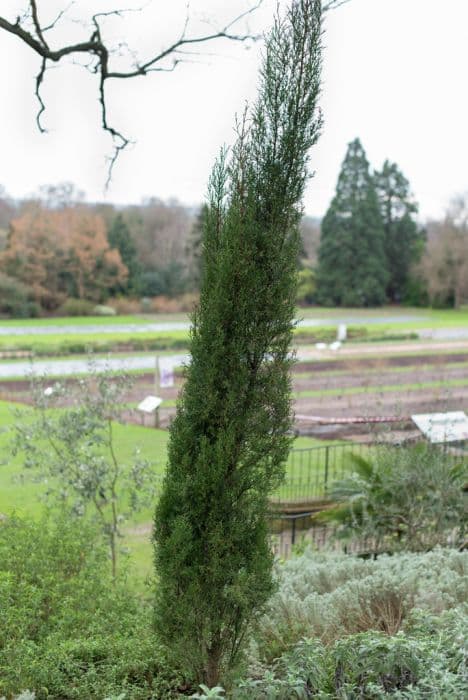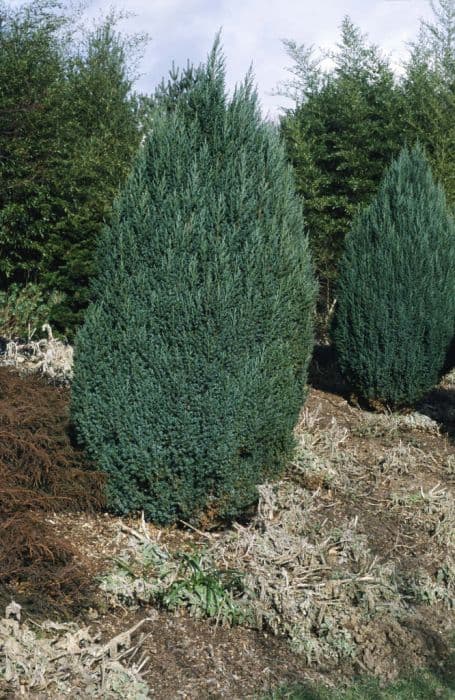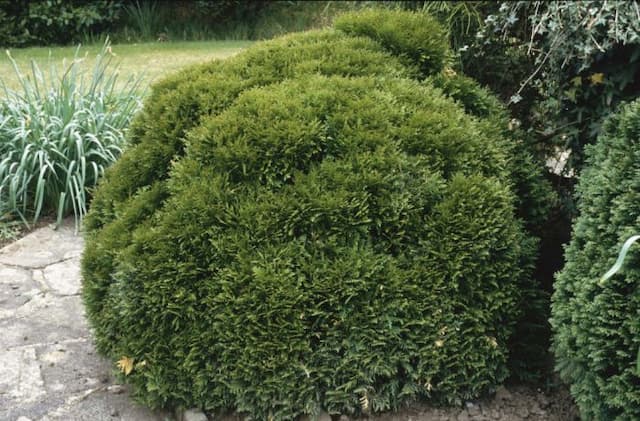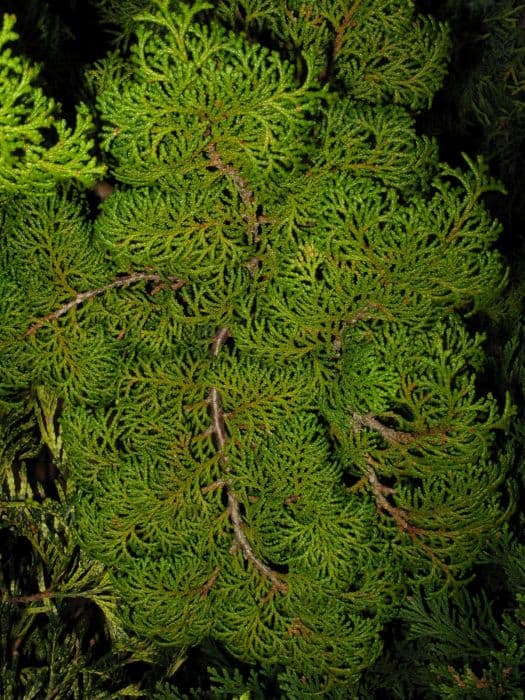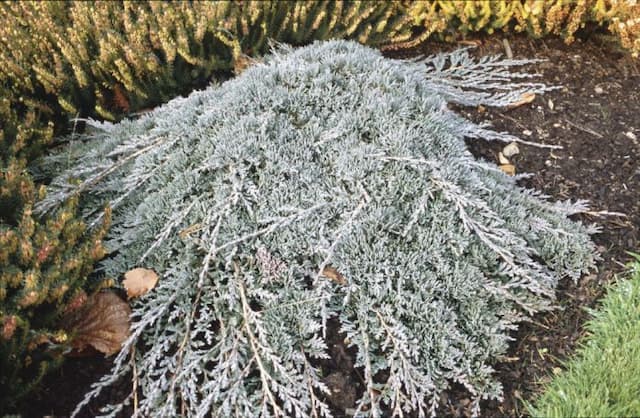Common juniper Juniperus communis



ABOUT
Juniperus communis, also known as common juniper, is a coniferous evergreen shrub or small tree that can reach up to 6-9 ft in height and 3-6 ft in width. It has a dense, pyramidal shape with a central trunk and spreading branches.
The leaves are needle-like, scale-like, or awl-like, and are arranged in a spiral pattern on the branches. They are dark green in color and have a glossy texture. The leaves are up to 1 inch long and and around 0,04 inch wide.
The tree produces small, round, berry-like cones, which are initially green and ripen to a blue-black color. The cones are about 0,4 inch in diameter and typically contain 1-3 seeds.
The bark of the tree is thin, brown, and fibrous, and can be either smooth or fissured. The wood is reddish-brown and fragrant.
Juniperus communis can be found in many forms, with different shapes, sizes, and foliage types, such as the prostratus, repanda, and stricta. They can be used as ornamental plants in gardens, parks, and as hedges.
About this plant
 Names
NamesFamily
Cupressaceae
Synonyms
Common juniper, Juniper
Common names
Juniperus communis
 Toxicity
ToxicityTo humans
Juniperus communis has been known to cause skin irritation and allergic reactions in some individuals.
The leaves, branches, and berries contain volatile oils that can cause skin irritation and itching when touched. Ingestion of the berries can cause stomach upset and can lead to kidney and liver damage.To pets
Juniperus communis can be toxic to animals when ingested in large amounts. The berries contain compounds that can cause vomiting, diarrhea, and abdominal pain. In severe cases, it can lead to kidney and liver damage, and even death.
The needles of the tree can also be toxic to animals if ingested, causing stomach upset and irritation.
It's important to keep animals away from the plant and ensure that they have access to safe plants to graze on.
 Characteristics
CharacteristicsLife cycle
Perennials
Foliage type
Evergreen
Color of leaves
Green
Flower color
Yellow
Height
Up to 9 feet
Spread
Up to 6 feet
Plant type
Shrub
Hardiness zones
2
Native area
Northern and central Europe, North Afric, western Asia
Benefits
 General Benefits
General BenefitsJuniperus communis is an attractive and versatile plant that can be used for landscaping, gardens and parks, and as hedges;
The plant is low maintenance and can tolerate a wide range of conditions, including drought and cold temperatures;
Juniperus communis is relatively resistant to pests and diseases, making it a good option for low-maintenance gardening;
The plant can help to reduce soil erosion and can provide a habitat for wildlife;
The wood of the shrub is fragrant and can be used in aromatherapy to promote relaxation and reduce stress;
The plant can be used as a natural barrier, privacy screen, and windbreak;
Juniperus communis is easy to propagate through seeds, cuttings, and layering, making it a versatile plant to use in gardens;
The plant has a long life, some species can live up to several centuries. Medical Properties
Medical PropertiesJuniperus communis has been traditionally used as a diuretic, helping to increase urine flow and reduce water retention;
The plant has been used to reduce inflammation and swelling in conditions such as rheumatism and arthritis;
The plant has been used as an antiseptic to clean wounds and prevent infection;
Juniperus communis has been used to relax muscle spasms and ease cramps;
The plant has been used to help clear mucus from the respiratory tract and ease symptoms of coughs and colds;
The plant has been used to relieve gas and bloating in the stomach and intestines;
Juniperus communis has been used as a stimulant to increase energy and reduce fatigue.
It's important to note that it is dangerous to use plants as a stand-alone treatment and it is important to consult a specialist before using juniperus communis or any other plant as a medicine.
Some people may be allergic to certain parts of the plant and using it may cause some side effects. Air-purifying Qualities
Air-purifying QualitiesThe plant can remove pollutants such as formaldehyde, ammonia, benzene, and xylene. These compounds can be found in many household products such as cleaning agents, carpets, and furniture, and can cause respiratory problems.
 Other Uses
Other UsesThe branches and needles of Juniperus communis can be dried and used as incense. The plant's fragrant oils are released when burned, creating a pleasant, woodsy aroma;
Berries of the Juniperus communis can be used as a food preservative, they are traditionally used to preserve meats and pickles;
The plant's essential oils can be used as a natural insecticide to repel insects such as mosquitoes, moths, and ants;
The plant's leaves and berries are edible and can be used as a food source for livestock such as sheep and goats;
The essential oils of the plant can be used to make soap;
The plant can be used as a natural barrier, privacy screen, and windbreak;
The wood of the tree is fragrant and can be used in aromatherapy to promote relaxation and reduce stress;
The berries of the Juniperus communis can be used to make a blue-gray dye.
Interesting Facts
 Feng Shui
Feng ShuiIn feng shui, Juniperus communis is believed to have a grounding energy that can help to balance and stabilize the energy in a space.
It is often used to create a sense of calm and tranquility, and is believed to help with mental clarity and focus. The plant is often placed in the east or southeast areas of a home or office to bring in positive energy and promote good luck and success. Zodiac Sign Compitability
Zodiac Sign CompitabilityCAPRICORN
Capricorns are known for their practicality, ambition, and hardworking nature, and Juniperus communis is believed to help support these traits. The plant is believed to be able to help Capricorns stay grounded and focused, which can help them achieve their goals more easily. Plant Symbolism
Plant SymbolismJuniperus communis has been used as a symbol in many different cultures and traditions. In many cultures, the plant is believed to have protective properties and is often used to ward off evil spirits and negative energy.
The plant is also often associated with purity and cleanliness.
In some cultures, the plant is believed to have healing properties and is often used in traditional medicine.
 Water
WaterJuniperus communis is relatively drought-tolerant once established, but it still needs regular watering to keep it healthy.
The shrub should be watered deeply and infrequently, about once a week.
It's important to check the soil before watering, if the top inch is dry, it's time to water. Overwatering can cause root rot, so it's important to avoid watering the tree too frequently. Light
LightJuniperus communis prefers full sun to partial shade.
It can tolerate some shade but it will grow best in a location that receives at least 6 hours of direct sunlight per day. Temperature
TemperatureJuniperus communis is a hardy plant and can tolerate a wide range of temperatures. It is cold hardy and can tolerate temperatures as low as -40°F. It can also tolerate heat, but it prefers temperatures between 60-85°F.
It's worth noting that in extreme temperatures, the plant may lose some of its leaves or become dormant. In this case, it's important to provide the plant with some protection and to ensure that it has access to water. Pruning
PruningJuniperus communis is relatively easy to prune and can be pruned at any time of the year. The shrub should be pruned to remove dead, diseased, or damaged wood, as well as to control its shape and size. Pruning should be done with sharp pruners or shears and should be done carefully to avoid damaging the plant.
 Cleaning
CleaningNot needed
 Soil
SoilJuniperus communis prefers well-draining, sandy soil with a neutral pH of 6.0 to 7.0.
It can tolerate a wide range of soils, but it prefers a soil that is not too heavy or clay-like. The plant will also do well in sandy, rocky soils. It's important to ensure that the soil is well-drained to prevent waterlogging. Repotting
RepottingThis is an outdoor plant, so transplanting is not required.
 Humidity & Misting
Humidity & MistingJuniperus communis is relatively tolerant of low humidity levels and can tolerate conditions from dry to moderate humidity.
However, if you live in a very dry area, it's important to provide the plant additional humidity. Suitable locations
Suitable locationsIndoor
Not growing
Outdoor
Juniperus communis is a hardy and versatile plant that can be grown outdoors in a variety of conditions.
The plant prefers full sun to partial shade, and can tolerate a wide range of temperatures.
It is also drought-tolerant, but still needs regular watering to keep it healthy, about once a week. It prefers well-draining, sandy soil with a neutral pH of 6.0 to 7.0, but can tolerate a wide range of soils.Hardiness zone
USDA 3 - 11
 Life cycle
Life cycleThe life cycle of Juniperus communis begins with the germination of a seed. The seed will germinate in the spring and will produce a small seedling. The seedling will develop into a young plant and will begin to grow leaves and branches.
As the young plant grows, it will continue to develop its root system and will begin to produce small, round berries. The berries will mature and will turn from green to blue-black in color. The berries are usually produced in the second year of growth.
As the plant matures, it will continue to grow and will develop a central trunk and spreading branches. The plant will reach its maximum height and width, and will continue to produce berries every year.
Juniperus communis is an evergreen plant, meaning it will keep its leaves throughout the year and will not lose them during the winter. Some species of Juniperus communis can live up to several centuries.
In terms of reproduction, Juniperus communis reproduces through seeds, that are produced in the berries, but it also can reproduce by layering and cuttings. Propogation
PropogationPropogation time
Fall; spring - summer
By SEEDS:
The best time to sow the seeds is in the fall, but it can also be done in the spring. The seeds need to be cold stratified before sowing, which means that they need to be kept in a cold and moist environment for a few weeks before planting. After that, the seeds can be planted in a well-draining seed compost and covered with a layer of soil. The seedlings will emerge in about 3-4 weeks.
By CUTTINGS:
Juniperus communis can be propagated by taking stem cuttings in the summer or early fall. The cuttings should be taken from the current year's growth and should be about 4-6 inches long. The cuttings should be removed the leaves from the bottom half of the cutting and dipped in rooting hormone before planting in a well-draining potting mix. The cuttings will root in about 4-6 weeks.
By LAYERING:
Juniperus communis can also be propagated by layering, which is a method of rooting a stem while it is still attached to the parent plant. The stem is bent down and a small trench is dug around the stem. The stem is then covered with soil, leaving the top of the stem exposed. The stem will root in about 4-6 weeks. Once rooted, the stem can be severed from the parent plant and planted in its own pot or in the ground.
 Pests
PestsSpider mite, Scale insects, Juniper scale, Bagworms
 Diseases
DiseasesRoot Rot, Rust, Canker

